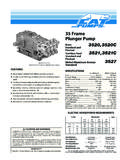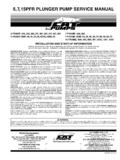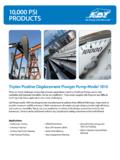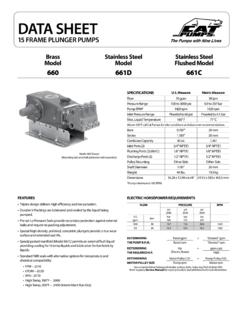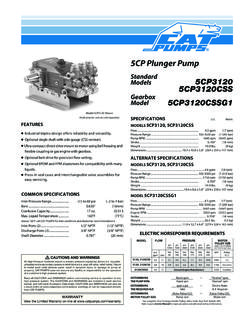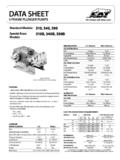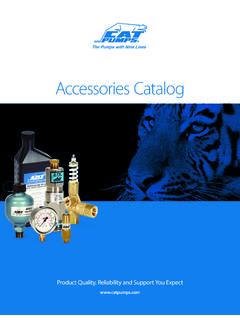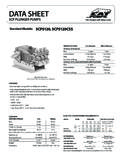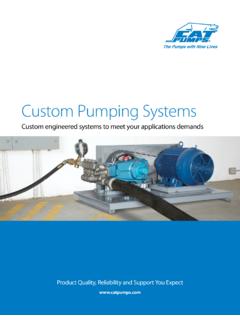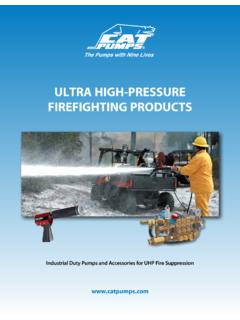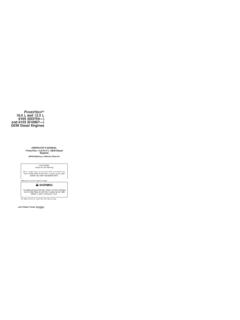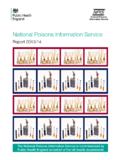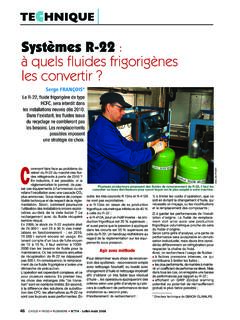Transcription of Material Safety Data Sheet - Cat Pumps
1 Material Safety data Sheet Crankcase Oil ISO 68 Special Formula Premium Grade Company Information Revision Date: June 30, 2011. Cat Pumps Includes Cat Pumps Part Numbers: 6100, 6102, 6105, 6107, and 6109. 1681 94th Lane Northeast Electronic MSDS Copy: Minneapolis, MN 55449 Emergency: 800-424-9300. Information: 763-780-5440. Composition Information Ingredients CAS # % OSHA TWA OSHA STEL ACGIH TWA SKIN. Severely refined mineral oils Mixture >90 5 mg/m3 10 mg/m3* 5 mg/m3 No (PEL)* (TLV). Proprietary additives Mixture -- -- -- -- No Zinc dithiophosphate 68649-42-3 < -- -- -- No Comments (*) Applicable to oil mist, not defined for base oils. TWA Time Weighted Average is the employee's average airborne exposure in any 8-hour work shift of a 40-hour work week which shall not be exceeded.
2 STEL Short Term Exposure Limit is the employee's 15-minute time weighted average exposure which shall not be exceeded at any time during a work day unless another time limit is specified. Hazardous Identification Warning MAY CAUSE EYE IRRITATION, MAY CAUSE SKIN IRRITATION. Eye Contact Direct contact may cause irritation, redness, tearing and blurred vision. Skin Contact Avoid prolonged skin contact. This product contains materials that may cause skin irritation. Prolonged or repeated contact may result in dermatitis (dryness, chapping, and reddening of skin). Inhalation Overexposure by inhalation of hot Material may cause nonspecific discomfort, such as nausea, headache or weakness. Caution should be taken to prevent aerosolization or misting of this product without proper respiratory protection.
3 Ingestion Do not ingest. Product is expected to be relatively non-toxic unless lung aspiration occurs. Aspiration is not expected with this Material due to viscosity. Should aspiration occur, it may lead to chemical pneumonitis which is characterized by pulmonary edema and hemorrhage and may be fatal. Signs of lung involvement include increased respiratory rate, increased heart rate, and a bluish discoloration of the skin. Coughing, choking and gagging are often noted at the time of aspiration. This product has laxative properties and may result in abdominal cramps and diarrhea. Other Not applicable First Aid Measures Eye Contact Check for and remove contact lenses. Flush eyes with cool, clean, low-pressure water for at least 15 minutes.
4 Hold eyelids apart to ensure complete irrigation of the eye and eyelid tissue. If irritation persists seek medical attention. If Material is hot, treat for thermal burns and take victim to hospital immediately. Skin Contact Remove contaminated clothing. Wash contaminated area thoroughly with soap and water. If redness or irritation occurs, seek medical attention. If Material is hot, submerge injured area in cold water. If victim is severely burned, remove to a hospital immediately. Wash contaminated clothing before reuse. Inhalation If overcome by inhalation of hot vapors, remove to fresh air. Use oxygen if there is difficulty breathing or artificial respiration if breathing has stopped. Do not leave victim unattended.
5 Seek immediate medical attention if necessary. Ingestion Do not induce vomiting unless directed by a physician. During vomiting there is a danger of aspirating liquid into lungs, causing serious damage and chemical pneumonitis. If spontaneous vomiting occurs keep head below hips to prevent aspiration and monitor for breathing difficulty. Gastric lavage should be performed only by qualified medical personnel. Keep affected person warm and at rest. Seek immediate medical attention. Other Not applicable Fire Fighting Measures Flash point 204 C (400 F) by ASTM D 92. Flammable limits Not determined Extinguishing media Use water spray, dry chemical, alcohol foam, all purpose AFFF or carbon dioxide to extinguish fire.
6 Special firefighting procedures Evacuate area and fight fire from a safe distance. If leak or spill has not ignited, ventilate area and use water spray to disperse gas or vapor and to protect personnel attempting to stop a leak. Use water spray to cool adjacent structures and to protect personnel. Shut off source of flow if possible (safely). Stay away from storage tank ends. Withdraw immediately in case of rising sound from venting Safety device or any discoloration of storage tank due to fire. Fire fighters must wear MSHA/NIOSH approved positive pressure breathing apparatus (SCBA) with full face mask and full protective equipment. Unusual fire & explosion hazards Dense smoke may be generated while burning.
7 Toxic fumes, gases or vapors may evolve on burning. High temperatures may create heavy flammable vapors that may settle along ground level and low spots to create an invisible fire hazard. Byproducts of combustion Fires involving this product may release oxides of carbon, phosphorus, nitrogen and sulfur; reactive hydrocarbons and irritating vapors. Auto ignition temperature Not determined Explosion data Not determined. Car should always be exercised in dust/mist areas. Other Not applicable Material Safety data Sheet Crankcase Oil ISO 68 Special Formula Premium Grade Accidental Release Measures Spill control procedures (land) Immediately turn off or isolate any source of ignition (pilot lights, electrical equipment, flames, heaters, etc.)
8 Evacuate area and ventilate. Personnel wearing proper protective equipment should contain spill immediately with inert materials (sand, earth, chemical spill pads of cotton) by forming dikes. Dikes should be placed to contain spill in a manner that will prevent Material from entering sewers and waterways. Large spill, once contained, may be picked up using explosion proof, non-sparking vacuum Pumps , shovels, or buckets, and disposed of in suitable containers for disposal. If a large spill occurs notify appropriate authorities. In case of road spill or accident contact Chem-Trec (800-424-9300). Spill control procedures (water) Try to contain large spills with floating booms to prevent spill from spreading.
9 Remove from surface by skimming or with suitable adsorbents. If a large spill occurs notify appropriate authorities (normally the National Response Center or Coast Guard at 800-424-8802). Waste disposal method Most oil based products are incinerated, land-filled or reclaimed. All disposals must comply with federal, state, and local regulations. The Material , if spilled or discarded may be a regulated waste. Refer to state and local regulations. Department of Transportation (DOT) regulations may apply for transporting this Material when spilled. See Transport section. Other CAUTION - If spilled Material is cleaned up using a regulated solvent, the resulting waste mixture will be regulated. Handling and Storage Handling procedures Keep containers closed when not in use.
10 Do not transfer to unmarked containers. Fire extinguishers should be kept readily available. See NFPA 30 and OSHA -- Flammable and Combustible Liquids. Empty containers retain product residue which may exhibit hazards of Material , therefore do not pressurize, cut, glaze, weld, or use for any other purposes. Return drums to reclamation centers for proper cleaning and reuse. Handling temperatures should not exceed 60 C (140 F) to minimize danger of burns. Open containers carefully in a well ventilated area or use appropriate respiratory protection. Wash thoroughly after handling. Storage procedures Store containers away from heat, sparks, open flame, or oxidizing materials. Product should not be stored above 45 C (113 F).
